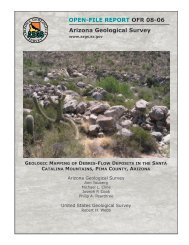Conglomerate Clast Counts in Oligocene-Miocene Strata North
Conglomerate Clast Counts in Oligocene-Miocene Strata North
Conglomerate Clast Counts in Oligocene-Miocene Strata North
You also want an ePaper? Increase the reach of your titles
YUMPU automatically turns print PDFs into web optimized ePapers that Google loves.
qt (quartzite): unmetamorphosed quartzite derived dom<strong>in</strong>antly from Precambrian Apache Group<br />
<strong>in</strong>clud<strong>in</strong>g Troy Quartzite (but <strong>in</strong> part from Cambrian Bolsa Quartzite or Abrigo Formation)<br />
ls (limestone): limestone derived predom<strong>in</strong>antly from Paleozoic strata (but perhaps <strong>in</strong> part from<br />
Precambrian Mescal Limestone of the Apache Group)<br />
wv (Williamson Canyon Volcanics): mafic volcanic rock derived from the Laramide<br />
Williamson Canyon Volcanics (Dripp<strong>in</strong>g Spr<strong>in</strong>g Mounta<strong>in</strong>s and Gila River gorge)<br />
li (Laramide igneous): felsic to <strong>in</strong>termediate porphyry and altered volcanic rocks of <strong>in</strong>ferred<br />
Laramide age (Late Cretaceous–Paleocene)<br />
tv (Tertiary volcanic): unaltered <strong>in</strong>termediate to mafic or felsic volcanic rocks derived from the<br />
Galiuro Volcanics (or correlative volcanic units exposed <strong>in</strong> multiple tiltblocks farther west)<br />
<strong>Clast</strong> Transects<br />
Sequential clast counts were made at multiple outcrop stations along selected well exposed<br />
cross-strike transects to test for stratigraphic variations <strong>in</strong> clast assemblages. Transects are<br />
arbitrarily labeled A through Z (the latter composited from strike transects ZL and ZU), with<br />
sequential numbers denot<strong>in</strong>g stations along each transect (A1, A2, etc., listed <strong>in</strong> order from<br />
downsection to upsection, or north to south for transect Z). Letters <strong>in</strong> parentheses denote the<br />
stratigraphy of each transect or station: b, Beehive Well Facies of San Manuel Formation (Camp<br />
Grant Wash); c, Cloudburst Formation and correlatives; h, Hackberry Wash Facies of Cloudburst<br />
Formation (Tortilla Mounta<strong>in</strong>s); k, Kannally Member of San Manuel Formation (Black Hills);<br />
s, San Manuel Formation (undivided) and correlatives; t, Tucson Wash Member of San Manuel<br />
Formation (Black Hills); and cs-hs, comb<strong>in</strong>ed Cloudburst(–Hackberry) and San Manuel strata <strong>in</strong><br />
cont<strong>in</strong>uous stratigraphic successions.<br />
Data Presentation<br />
Figure 1 is an overview of the study area show<strong>in</strong>g the distribution of mid-Tertiary strata and the<br />
spans of Figures 2-4. Figure 2 shows the general geologic context of the Guild Wash and Star<br />
Flat allochthons and the locations of clast transects A-C. Figure 3 shows the Black Hills area<br />
(transects D-I) and the Camp Grant Wash area (transects J-P). Figure 4 shows the James Wash<br />
area (unsampled), the Tortilla Mounta<strong>in</strong>s (transects Q-Y) and Ripsey Wash (strike transects ZL-<br />
ZU). Figure 5 (same base as Figure 1) <strong>in</strong>dicates key onlap-overlap relations of Cloudburst and<br />
San Manuel strata.<br />
Table 1 lists the locations and stratigraphy of the clast transects, Table 2 is a compilation of<br />
frequency percentages of clast types at each station along the clast transects, Table 3 is a<br />
summary of notable areal and stratigraphic variations <strong>in</strong> clast type, and Table 4 tabulates<br />
available paleocurrent data for mid-Tertiary strata with<strong>in</strong> the study area from Weibel (1981),<br />
Hansen (1983), Dick<strong>in</strong>son (1991), and this study.<br />
2

















